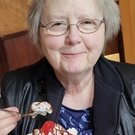Mojmir Frinta
ALTAMONT — Mojmir Frinta wrote this memoir before his death on Wednesday, Jan. 21, 2015.
The family of Mojmir Frinta moved to Altamont in 1963 from New York City when Professor Frinta received an appointment at the State University of New York (now the University at Albany). He was the first art historian in the expanding program housed in the Art Department.
In 1965, he became an associate professor and in 1969 a professor of art history. He retired after teaching for 30 years and became professor emeritus in 1993. In the fall of 1991, he was a visiting professor at his first alma mater school, Karlova Universita (Charles University) in Prague, Czechoslovakia, soon to become the Czech Republic.
Interest and loyalty of the whole family to the New York State public university system is evidenced by three of its members enrolling in the State University programs: Irena Frinta received a master of arts degree at Albany in 1970 while teaching art at the public schools. The older son, Daniel, also got his bachelor of arts degree from Albany in 1975, and the younger son, Richard, earned a bachelor of arts degree from Oswego College in 1979. Daughter Dagmar, however, earned her bachelor of arts degree at Syracuse University in 1978 and then became an art instructor for many years at the Rhode Island School of Design.
In Altamont, the Frintas rented for two years an apartment next to the Masonic temple and then they bought a house at 150 Maple Avenue.
The education of Professor Frinta was thoroughly international — centering on Czechoslovakia, France, and the United States. In 1947, he went on a fellowship (Bourse d’Echange du Gouvernement Francais) to Paris to study art and art history.
In 1948, he married Irena Altmanova and they resided in Paris for four years before emigrating in 1951 to the United States. Since his early school years, he wanted to be a painter: After earning his baccalaureate, he enrolled at the College of Applied Arts in Prague but soon afterwards he was forced to work as an “Hilfsarbeiter” in a German airplane factory for three years.
After the liberation in 1945, he added his interest in the history of art and continued in this double direction in Paris (at the Ecole des Beaux Arts he studied fresco painting and lithography). This dual orientation continued up to his times at the University of Michigan in Ann Arbor and was reflected in his specific approach by integrating art technological themes. In 1953, he received a master of fine arts degree at the University of Michigan at Ann Arbor.
Intellectual disagreement with the then dominant tendencies in contemporaneous art may have contributed to his gradual withdrawal from practicing art but at the same time enriched his grasp of understanding some essential creative aspects in the art history discipline.
In 1955, he became a candidate for Ph.D. in art history and received it in 1960. On the merits of his expertise in art restoration (he worked as a restorer for two-and-a-half years in Paris) he became a staff member in 1955 at the Metropolitan Museum of Art in New York and in view of his special interest in medieval art was associated with the Medieval Department and The Cloisters as a senior restorer until 1963 when he decided to go into teaching.
Mojmir Frinta was wholeheartedly engaged in scholarly research of later medieval painting and sculpture of the 14th and 15th centuries and published many articles in scholarly publications of various countries. He was attracted by problematic cases that seemingly were resolved but probing of which had revealed serious questions.
His research was always aimed at providing an alternative interpretation for the proposals that occasionally strained the logic. Uncovering the “truth” was always his ultimate goal. And his intensely individualistic and independent mind made the effort conceivable and fruitful.
Late medieval painting and sculpture around 1400 in Central Europe preoccupied strongly his imagination and this emotional attachment can be explained from the fact that Mojmir Frinta was born in Prague, Czechoslovakia in 1922. His doctoral dissertation for the University of Michigan was on the sculpture of the “Beautiful Style” in Central Europe.
Two other substantial periods that intrigued him were the early Netherlandish bafflingly realistic painting and the great tradition of Byzantine icon painting. From the first period came his innovating book The Genius of Robert Campin, published in the Netherlands in 1966.
His major work on which research he spent most of his time since the middle of the sixties was the study of a special kind of punched decoration of gilt surfaces in panel paintings that was largely favored by Italian Trecento and Quattrocento painters. To gather the evidence, he visited every attainable site to photograph macro details which amount to some 15,000 life-size details, produced by his trips to Europe every summer.
Over 3,000 of those were illustrated in the first part of the study, which has 700 pages of comprehensive catalogue of all punch shapes. It was published in Prague in 1998 while the other part — interpretation of the phenomenon had to wait a dozen years due to the inactivity of the publisher in Prague.
Mojmir Frinta was a man of wide horizons with a vital interest in the world’s cultures and made great effort to convey this all-embracing attitude to his children, and the whole family traveled several summers through Europe and spent two years with him in Florence during his two sabbaticals. Lately, Mojmir and Irena joined a series of guided tours of the Mediterranean and Near Eastern regions, from Morocco to Tunisia, Spain, France, Italy, Greece, Cyprus to Turkey and Egypt fostered by his interest in the most refined art forms.



